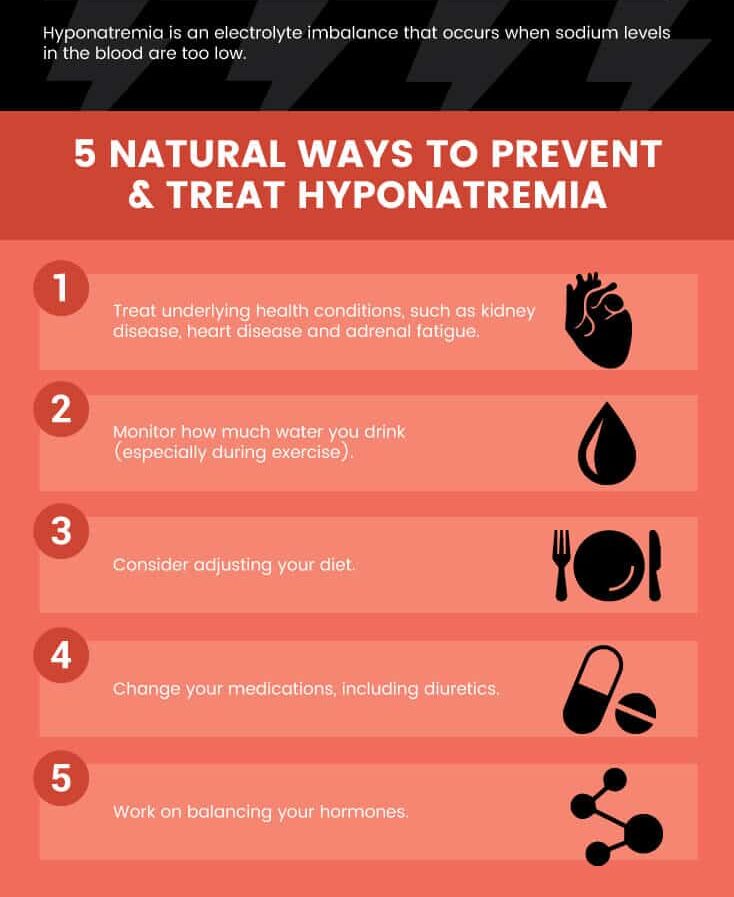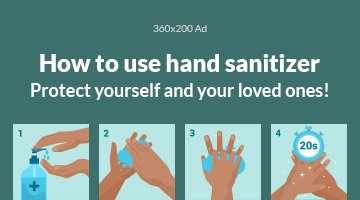Hyponatremia means low sodium levels in the blood. It’s the opposite of the condition called hypernatremia, in which sodium levels are very high.
Both conditions often occur when patients are staying in the hospital. This is especially true if they are receiving fluid intravenously, have an existing condition like kidney or heart disease, or are in critical care.
Surveys have found that hyponatremia develops in 15 percent to 30 percent of all patients during hospital stays. Hyponatremia and related electrolyte imbalances can develop during exercise or in extreme heat, when dehydration symptoms are more common.
When hyponatremia is mild or sometimes even moderate, it’s commonly asymptomatic. This means no noticeable symptoms occur that the patient is aware of. However, when it’s more severe, hyponatremia symptoms typically include headaches, nausea, and in some cases even seizures or a coma.
Treatment for hyponatremia usually comes down to regulating fluid levels in the body. In other words, intake and excretion of salt versus water must be balanced.
Ad
Ways you can prevent hyponatremia from developing or reverse the condition once it’s already occurred include:
- drinking the right amount of water in proportion to how much sodium you’re losing
- eating a balanced diet
- taking care of your adrenal glands
- making an effort to balance hormone levels
What Is Hyponatremia?
Hyponatremia is a type of electrolyte imbalance characterized by having abnormally low sodium levels in the blood.
Sodium (salt) often gets a bad rap because too much of it affects blood pressure and contributes to fluid retention/swelling. However, it’s actually an essential electrolyte.
All electrolytes have important jobs throughout the body. This is because of how they carry an electric charge when dissolved in bodily fluids, including blood.
Some of the roles that sodium has include:
about:blank
- Helping regulate the amount of water that’s in and around your cells
- Controlling blood volume
- Regulating blood pressure
- Allowing your muscles and nerves to work properly
What is considered low sodium versus normal sodium?
- Normal sodium levels are 135–145 mEq/L.
- Hyponatremia is defined as a serum sodium level of less than 135 mEq/L.
- Mild hyponatremia is between 130–134 mmol/L.
- Moderate is between 125–129 mmol/L.
- Severe is anything less than 125 mmol/L.
The doctor will adjust fluids to correct the imbalance, depending on if a patient has hyponatremia (too little salt in the blood) or hypernatremia (too much salt). To prevent electrolyte imbalances, you can monitor your water intake, diet and medications.
Normally your body obtains sodium through your diet and loses the right amount through your urine or sweat. So, as long as you don’t have kidney problems, you should be able to naturally balance sodium and water levels by making a few healthy changes.
Symptoms
The problem with having too little sodium and, at the same time, too much water is that it causes your cells to swell. Depending on how much swelling and fluid retention occurs, hyponatremia can be very serious — even deadly in severe cases.
The most common hyponatremia symptoms include:
- Digestive issues, like nausea, diarrhea and vomiting
- Headaches
- Dizziness and instability
- Muscle weakness
- Trouble concentrating and confusion
- Low energy, lethargy, even if you’ve slept enough, and fatigue
- Mood changes and increased irritability
- Muscle pains, spasms or cramps
- Rhabdomyolysis
In severe cases when the condition isn’t treated, brain swelling, seizures, and possibly coma or death can occur. In the elderly, hyponatremia can also cause falls, injuries and gait disturbances due to instability and weakness.
Causes and Risk Factors
Hyponatremia happens when sodium levels in your body become too diluted. Too much water is present in the blood in proportion to sodium.
Hyponatremia symptoms and complications are caused by cells swollen with water, which causes fluid retention. This can even lead to serious neurologic impairments and fluid retention in the brain (brain edema).
Hyponatremia is categorized into several categories/types depending on how blood volume and total fluid levels are impacted. In other words, it’s categorized depending on the cause:
- Euvolemic hyponatremia is when water levels increase, lowering the level of sodium based on blood volume.
- Hypovolemic is when blood volume and sodium are both low.
- Hypervolemic is when blood volume and sodium are both increased, but sodium is too low in proportion to water.
- Hyponatremia that develops over 48 hours or longer is considered “chronic hyponatremia.” This is usually riskier due to potential complications. It’s also harder to treat. However, if it develops very rapidly, it’s called “acute hyponatremia.” Acute hyponatremia can be easier to control with treatments like intravenous fluids.
Situations and health conditions that cause hyponatremia most often include:
Ad
- An existing/underlying medical condition that affects sodium levels, your thirst sensation and the role of the kidneys (such as kidney disease, which alters urine production), along with heart or liver problems. Kidney disease and heart disease are common conditions that both contribute to hyponatremia.
- Being a premenopausal woman. Premenopausal women appear to be at the greatest risk of hyponatremia. This is due to how women’s sex hormones affect fluid and sodium levels.
- Hormonal imbalances or changes that affect the adrenal glands. The adrenals normally produce hormones that help maintain your body’s balance of electrolytes (including sodium, potassium and water). Reasons that hormone production can change include adrenal gland insufficiency (Addison’s disease) and thyroid disorders/damage.
- Chronic, severe vomiting or diarrhea due to an illness. This can cause dehydration (taking in too little electrolytes through foods and fluids).
- Drinking too much water. This can happen in very hot temperatures, when someone is fasting, or during exercise and endurance sports. Studies show people who partake in marathons, ultra-marathons, triathlons and other long-distance, high-intensity activities are at an increased risk of hyponatremia.
- People following restrictive diets that are very high in water and hydrating foods but low in sodium (like raw food diets or fruit-only diets).
- Older age. The elderly and older adults develop symptoms of hyponatremia more often than younger people. This is especially true if they take medications that impact fluid levels, have been staying in the hospital or are sick.
- Taking medications that alter sodium/water levels. Drugs that can cause or contribute to hyponatremia include thiazide diuretics, antidepressants and pain medications.
- Producing high levels of the anti-diuretic hormone (ADH). This causes your body to retain water instead of excreting it normally in your urine.
- Using recreational drugs, including ecstasy.

Conventional Treatment
When a patient sees a doctor regarding hyponatremia symptoms or is already staying in the hospital when the condition develops, the health care provider will usually look for any indication of electrolyte imbalance by taking several measurements:
- Plasma sodium (amount of sodium in the blood)
- Plasma osmolality (osmolality tests provide a snapshot of the concentration of solutes in a given volume of bodily fluid, in this case the amount of water and sodium present in the blood/serum)
- Urine sodium (how much sodium the body is excreting in urine)
- Urine osmolality (concentration of solutes in the urine)
- Assessment of the patient’s symptoms or signs that represent an electrolyte imbalance, like nausea, vomiting, dizziness or diarrhea
Once your doctor diagnoses you with hyponatremia, he or she might decide to restore normal fluid levels by giving you intravenous fluids or medications. These will depend on what type of hyponatremia you have and how it impacts your total blood volume. The goal of fluids and medications is to raise sodium levels/low water retention.
Typical treatment for hypovolemic hyponatremia is administering saline solutions to bring up sodium levels. If water levels in the blood are too high (euvolemic hyponatremia), then water/fluid restriction will be prescribed for a period of time. Sometimes, in addition to reducing water intake and increasing sodium, you also may need to take diuretics (which increase urination).
When hyponatremia is severe and brain damage is possible, around 3 percent sodium solution is usually administered to control complications.
Prevention and Natural Treatments
1. Treat Underlying Health Conditions
Kidney dysfunction, kidney disease, liver disease or damage, thyroid disorders, adrenal fatigue, and heart disease can all increase your risk for hyponatremia, so it’s important to treat these underlying conditions. If you have any of these health problems, be sure to monitor your symptoms closely, eat a healthy diet and speak to your doctor about ways to control fluid levels so too much fluid/water does not accumulate in your body.
Anyone with these conditions needs to be especially careful not to dilute the amount of sodium in her body too much through medications, intense exercise, diarrhea or vomiting, etc.
Because your adrenal glands produce hormones that control fluid levels in your body, improving adrenal health is an important step in preventing symptoms due to electrolyte imbalances. Dietary steps you can take to take care of your adrenals include eating more fresh veggies and fruits, foods high in B vitamins (like fish or eggs), mushrooms, coconut oil/coconut milk, and seaweed.
Reducing stress, getting enough rest and sleep, plus exercising in a healthy way (not too much or too little) can also keep your adrenals working properly.
2. Monitor How Much Water You Drink (Especially During Exercise)
While drinking enough water is generally very important for numerous bodily functions, drinking too much (especially within a short period of time) is also possible. Drinking too much water will dilute the amount of sodium in your blood in proportion to water, triggering the symptoms described above. You might also lose some sodium through sweat if you’re intensely exercising when hyponatremia develops, such as when completing a marathon.
When you’re active, you might think it’s best to keep drinking as much water as possible in order to stay hydrated. If you’re losing lots of electrolytes through your sweat, what you actually might need is an electrolyte drink that supplies sodium (in addition to other electrolytes).
Try to drink only as much fluid as you are thirsty for and are losing due to to sweating. A good rule of thumb is to drink eight to 10 ounces of water 15 minutes before you begin working out and then during your workout drink another eight ounces every 15 minutes.
Another good way to know if you’re drinking about the right amount of water during the day (even you’re not active) is to check the color of your urine. You’re looking for a pale yellow color as often as possible, as opposed to clear or very dark.
3. Consider Adjusting Your Diet
If you consume very high amounts of hydrating foods plus water but not enough natural sea salt or sodium, it can help to make some changes. The primary way that we obtain sodium is from consuming it through your diet in the form of sodium chloride, or table salt.
Today the average person gets more than 75 percent of their sodium from processed foods, including low-quality meat products, frozen dinners, condiments, canned goods, fried or fast foods, etc. Some names that sodium goes by in these processed foods include monosodium glutamate (MSG), sodium nitrite, sodium saccharin, baking soda (sodium bicarbonate) and sodium benzoate.
Rather than getting enough sodium from these unhealthy foods, try adding real sea salt, such as pink Himalayan salt, to your meals that you make yourself at home. This way you can control the amount of salt you’re taking in. (Plus you’ll get many more benefits due to obtaining numerous minerals if you use real sea salt.)
Some healthy foods also naturally provide smaller amounts of sodium, including meat, milk, beets and celery.
4. Change Your Medications, Including Diuretics
If medications, such as diuretics or antidepressants, are contributing to your condition, then your doctor can recommend how to change your dosage in order to increase sodium levels and prevent water retention safely. Although you should never change medications or stop taking them without speaking with your doctor first, you might be able to help treat conditions like bloating, anxiety and depression using natural remedies like a healthy diet, essential oils, exercise, stress reduction and certain supplements.
5. Work on Balancing Your Hormones
If you’re currently pregnant, going through menopause or experiencing other hormonal changes, this may be one reason you’re experiencing swelling, fatigue, mood changes, etc., due to electrolyte changes. Premenopausal women appear to be at the greatest risk of hyponatremia due to how women’s sex hormones affect fluid and sodium levels. Those with stressed adrenal glands are also an increased risk.
Once you’ve ruled out disorders like adrenal gland insufficiency (Addison’s disease) and thyroid disorders/damage, work on balancing your hormones naturally through exercise, stress-reducing practices (like yoga, deep breathing or meditation), eating a nutrient-dense diet, using hormone-balancing essential oils and possibly taking herbs/supplements that can help.
Benefits of Sodium
Sodium is an essential mineral that plays a crucial role in maintaining various bodily functions. While excessive sodium intake can be harmful, moderate amounts are necessary for health, and that’s why low sodium can be harmful too.
Here are some of the health benefits of sodium:
- Electrolyte Balance: Sodium, along with potassium and chloride, helps maintain the balance of electrolytes in the body, which is essential for proper nerve function, muscle contraction and fluid balance.
- Fluid Balance: Sodium helps regulate the balance of fluids both inside and outside of cells. This balance is critical for maintaining healthy blood pressure levels and preventing dehydration.
- Nerve Function: Sodium ions are involved in generating nerve impulses that allow for communication between nerve cells. This is crucial for various bodily functions, including muscle contraction, heartbeat regulation and cognition.
- Muscle Function: Sodium plays a role in muscle contraction by facilitating the transmission of nerve impulses to muscle cells. Adequate sodium levels are necessary for proper muscle function and preventing muscle cramps.
- Blood Pressure Regulation: Sodium works alongside other minerals like potassium to regulate blood pressure. However, excessive sodium intake can contribute to high blood pressure, which increases the risk of cardiovascular diseases.
- Nutrient Absorption: Sodium helps facilitate the absorption of certain nutrients, such as glucose and amino acids, in the small intestine.
Precautions
If you have mild symptoms, like some muscular weakness or headaches, after intense exercising or spending time in high temperatures/humidity, there’s probably no need to see a doctor. If you suddenly have unexplained symptoms that indicate an electrolyte balance, especially after high-intensity activities, or if you have conditions like low blood pressure and/or diabetes, then visit your doctor.
Look out for signs and symptoms of low blood sodium that come on suddenly. This is important after a hospital stay, surgery, partaking in a marathon/long-distance race, a bout of dehydration or illness (like a fever).
Get to know any side effects that might occur due to medications you take or from an existing illness. Take precaution if symptoms last for more than one day, getting help right away to prevent the situation from worsening.
Final Thoughts
- Hyponatremia is an electrolyte imbalance caused by too little sodium in the body in proportion to water.
- Symptoms like nausea, vomiting, loss of appetite, headaches, weakness, fatigue and confusion characterize hyponatremia. Complications in severe cases can include brain damage due to swelling, falls, seizures and coma.
- Treatments for hyponatremia include drinking the right amount of water in proportion to how much sodium you’re losing, managing underlying health conditions, eating a balanced diet, taking care of your adrenal glands and balancing your hormone levels.





